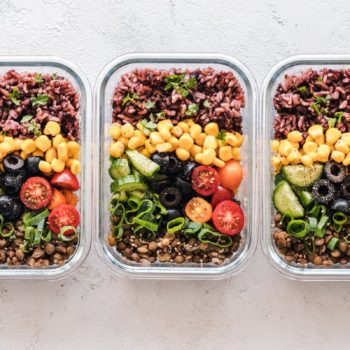Hypertrophy 101: What is Muscle Hypertrophy?

Hypertrophy – sounds a bit like a made-up word, right? Well, it isn’t. Muscle hypertrophy is the way your muscles build size and shape.
If you’re putting the hours in at the gym but not seeing any growth, understanding the process around muscle building might be the answer to your struggles.
If improved muscle definition is your goal, read our guide to muscle hypertrophy and discover the science behind it all.
By the end of this article, you’ll know exactly what is holding you back and what to do to achieve muscle growth in all the right areas.
What is hypertrophy?
Hypertrophy is the word used to describe the enlargement of an organ or tissue due to the increase in size of its cells. In terms of muscle hypertrophy, it’s the result of individual muscle fibers increasing in volume due to increased exertion and overloading.
There are two types of muscle hypertrophy that we know of1:
- Myofibril hypertrophy – achieved through the growth and number of the myofibrils inside each muscle fiber
- Sarcoplasmic hypertrophy – achieved through an increase of the sarcoplasmic fluid surrounding the myofibrils in your muscles
Myofibrils are the elongated threads found in skeletal muscle fibers. Sarcoplasm is the fluid and energy resources that surround the myofibrils. Myofibrillar hypertrophy is considered the most functional form of muscle building.
How does muscle hypertrophy happen?
Hypertrophy is a complex process involving the interaction of the nervous system, stimulation and repair.
It occurs primarily through recurring anaerobic, high-intensity resistance activity such as weightlifting2. It can also be achieved through a combination of diet and nutritional supplementation.
Whenever you train a muscle, your nerve impulses provoke muscle contraction – the stimulation. This puts your muscle under strain, causing damage to the muscle fibers. Your body breaks these muscle fibers down during the workout until they are ready to be repaired. This is then when muscle growth occurs3.
This process signals a cellular response. Your body works to replace the damaged cells, with new, stronger ones to help your body adapt to the strain you’ve placed it under. These cells fuse with existing muscle fibers to help them regenerate4, thicken and grow.
How do you achieve hypertrophy?
Achieving muscular hypertrophy is possible with a strict workout regime but can depend on your goals as well as your genetic make-up.
For some people, muscle hypertrophy is easy to achieve. Others may put the same amount of work in but struggle to see any results because of their genetics. In one classical twin study, it was discovered that about 45% of the variance in muscle fiber proportion is genetic and inherited5. For men, hypertrophy occurs at a higher rate during puberty and simmers down in the late teens.
The key to muscle hypertrophy is to train consistently and perform a combination of myofibril and sarcoplasmic hypertrophy. At the end of the day, it all comes down to the way you challenge yourself. According to the National Strength and Conditioning Association (NSCA), you should:
- First, determine your 1 rep max (RM) for a muscle – that’s the heaviest weight you can lift for just one rep6
- Adjust that weight appropriately as your strength improves
To avoid hitting a plateau, you need to up your weight and opt for high-volume reps to challenge your body.
These weight-lifting schedules may help you achieve muscle hypertrophy:
- Lifting lightly over three days a week: Start out with 6-12 reps over 3-4 sets, reducing rest periods to keep your muscles engaged. Ideally, high-volume reps and a low-to-medium weight will trigger a response in your muscles and boost their growing potential.
- Lifting heavier over two days a week: Reduce to 3-5 reps over 3-4 sets with a heavier load. Training with a heavier load on a moderate volume may impose a higher amount of mechanical stress on your muscles.
- Swap between upper- and lower-body lifting over three days a week: Choose between heavier or lighter lifting on different days. Work different muscles groups to allow for enough rest and recovery between days.
You may also want to concentrate on isolation and compound movements. Both offer different benefits which we’ve put into a nutshell below…
Compound movements such as squats and deadlifts can:
- Exercise multiple muscles at once
- Improve body functionality
- Burn more calories
- Make you stronger
Isolated movements such as bicep curls and leg extensions can:
- Target specific muscles
- Fix muscle imbalances
- Help with injury recovery
Types of exercises for muscle hypertrophy
We’ve mentioned how you achieve muscle hypertrophy, but what exercises generate that pump?
If you’re not sure where to start, we’ve put together a range of hypertrophy workouts to target specific areas of your body.
These workouts focus in on all the right muscles to help you craft the physique you’re after.
Top tip: Remember to keep good form and reduce your rest periods to keep up the intensity.
Total body hypertrophy workout
We couldn’t mention compound exercises without including any for you to practice. If you want to add some shape to multiple muscle groups, then this total-body workout is for you.
If you’ve never performed these moves before, work with a personal trainer or fitness professional to master the form. Once your technique is on form, you can do the exercises on your own.
- Deadlift – 3 sets of 8 reps
- Bench press – 3 sets of 8 reps
- Squats – 3 sets of 8 reps
- Bent over row – 4 sets of 10 reps
- Kettlebell swings – 3 sets of 12 reps

Chest hypertrophy workout
The chest is the one muscle group that many people struggle to develop but once you have it, it’s so worth it. Turn your chest game up a notch with this workout and activate that toned torso.
- Incline dumbbell press – 3 sets of 12 reps
- Push-up – 3 sets of 10 reps
- Cable crossover – 4 sets of 8 reps
- Seated chest press– 4 sets of 10 reps
- Dumbbell pull over – 3 sets of 10 reps
Leg hypertrophy workout
True leg day means you’re not walking anywhere the next day. This leg hypertrophy workout will pump your quads and define your hamstrings, ensuring maximum lower-body muscle growth.
- Front squat – 3 sets of 10 reps
- Leg extension – 4 sets of 12 reps
- Leg press – 2 sets of 15 reps
- Hamstring curl – 2 sets of 10 reps
- Lunges – 2 sets of 12 reps
- Good mornings – 3 sets of 12 reps
Back and shoulder hypertrophy workout
Broad shoulders and a well-defined back are the very definition of aesthetics. You can achieve both with this back and shoulder hypertrophy workout.
Single-arm bent over dumbbell row – 3 sets of 12 reps
Seated lat pull down – 4 sets of 10 reps
Seated cable row – 4 sets of 12 reps
Pullup (assisted if necessary) – 3 sets of 10 reps
Shoulder press – 3 sets of 10 reps
Alternating dumbbell front raise – 2 sets of 10 reps each arm
Standing military press – 2 sets of 10 reps

Arms hypertrophy workout
Think bulging biceps and tired triceps – yes, your muscles will hate this workout.
Stretch your upper limbs to their maximum muscle-growing potential with this arms hypertrophy workout.
Bicep curl – 4 sets of 12 reps each arm
Diamond press up – 4 sets of 8 reps
Triceps extensions – 3 sets of 12 reps
Leant forward EZ bar curl – 2 sets of 12 reps
Seated palms up barbell wrist curl – 3 sets of 10 reps
Tricep pushdown – 3 sets of 8 reps
Tips to maximize muscle size
You know how to achieve muscle hypertrophy, but how can you keep on top of the gains you’re building?
It’s not all train, eat, sleep, repeat. We’ve got a few extra tips to give you a bit of a method to the muscle madness.
- Commit
It takes motivation and time to build muscle. Train at least three times a week to keep your body engaged. As your body adjusts to this type of training, you’ll notice you’ll be able to do more, but don’t go too hard.
- Keep a workout diary
Keep on top of what you’ve achieved in each training session. Write down as much as you can about the session including the types of exercises, reps, sets, the weight used, your rest periods and how you felt. You can also set goals and monitor your progress – just remember to be patient.
- Get plenty of rest
Muscle repair happens when you’re under the covers. For this reason, we recommend you get between seven and eight hours of sleep a night to give your body the time it needs to recover and develop muscle.
- Up your protein
Protein is arguably the most important aspect of muscle building nutrition. It helps increase physical performance, training session recovery and lean body mass7. When building muscle, we recommend you try to consume around one gram of protein per pound of bodyweight8 per day throughout the day. Drinking a protein shake before you head to the gym can also jump-start muscle recovery9 and optimize protein synthesis.
- Push yourself to near failure
Failure is not a negative in this instance. When training, try and push yourself to do one more repetition until you fail. Training to failure can boost hypertrophy and lead to increased lactic acid production which is vital for muscle growth10.
- Try a creatine supplement
Creatine is produced in the body to help your body recover between sets. A creatine supplement may enhance recovery speed, allowing you to push yourself to the limit during a workout. Over time, this can lead to increased muscle mass and size. Creatine has also been shown to increase lean tissue mass and muscular strength during resistance training11.
- Don’t snub carbs
Carbohydrates are certainly not the devil when you’re strength training. In fact, they are the foods that fuel your muscles and give you the energy to push through to that final rep. Carbs also help reduce muscle damage and soreness12. So, carb up and enjoy.
- Don’t skip meals
Muscle building requires a great deal of energy, so don’t deprive your body. With each missed meal, you miss out on the opportunity to maximize muscle growth. Try preparing your meals for the day ahead in advance so you have fuel at hand when you need it. Check out our guide to the best muscle-building foods for some more inspiration.
- Keep hydrated
Getting enough water is vital for every bodily function. High-volume and intense exercises like the above are hard work. They’ll make you sweat, which means you’ll lose water. Low levels of water in your blood can result in poor circulation causing your muscles to fatigue faster. Make sure you are well hydrated throughout the day – glugging the recommended six to eight glasses a day13 should do the trick.
- Try supersets
Supersets work great for developing muscularity. You do two exercises consecutively with little or no rest between to target the same muscle group and activate all of the muscle fibers. By supersetting exercises, you can do more reps and work the muscle harder in each workout. That means more muscle power. As long as your workout plan is well-designed and the superset muscle groups don’t hinder one another, give them a go.
The Final Word
Muscle hypertrophy can be achieved through a well-designed weightlifting plan and of course, rest.
Follow the workout and nutrition tips in this article and you’ll make the gains you’ve been yearning for. Be sure to place specific focus on each muscle group in your body to achieve a symmetrical physique.
Happy lifting.



